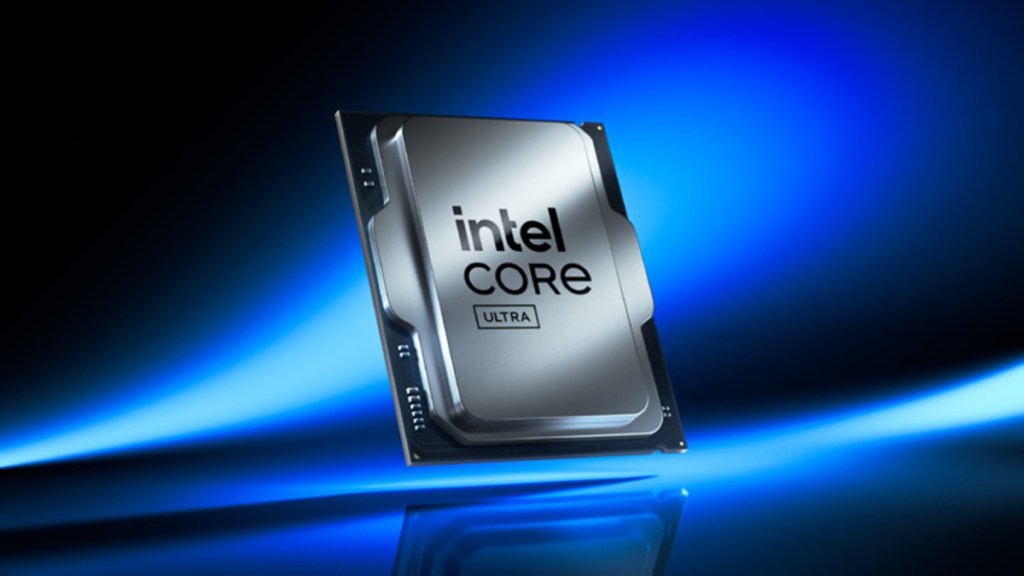Having to hand your iPhone over to someone can be a fairly common occurrence. Maybe your little nephew wants to play a game or your friend wants to check out the photos from your last vacation. Whatever the reason, no matter how much you trust that person, there are probably parts of your phone that you’d rather they didn’t see (even accidentally).
Technology
Intel Core Ultra 200S desktop processor debuts for AI PCs for enthusiasts

Join our daily and weekly newsletters for the latest updates and exclusive content on industry-leading AI coverage. Learn More
Intel launched the new Intel Core Ultra 200S series processor family that will scale AI PC capabilities to desktop platforms and usher in the first enthusiast desktop AI PCs.
Led by the Intel Core Ultra 9 processor 285K, the latest generation of enthusiast desktop processors includes five unlocked desktop processors equipped with up to 8 next-gen Performance-cores (P-cores), the fastest cores available for desktop PCs1, and up to 16 next-gen Efficient-cores (E-cores) that altogether result in up to 14% more performance in multi-threaded workloads than the previous generation.
The new family are the first neural processing unit (NPU)-enabled desktop processors for enthusiasts and come with a built-in Xe GPU with state-of-the-art media support.
“The new Intel Core Ultra 200S series processors deliver on our goals to significantly cut power usage while retaining outstanding gaming performance and delivering leadership compute. The result is a cooler and quieter user experience elevated by new AI gaming and creation capabilities enabled by the NPU, and leadership media performance that leverages our growing graphics portfolio,” said Robert Hallock, vice president and general manager of AI and Technical Marketing at the Client Computing Group at Intel, in a statement.
Why it matters
Thanks to the latest Intel core and efficiency innovations, Intel Core Ultra 200S desktop processors deliver a landmark reduction in power usage with up to 58% lower package power in everyday applications4 and up to 165W lower system power5 while gaming.
The new processor family combines improved efficiency with improved performance, also delivering up to 6% faster single-threaded6 and up to 14% faster multi-threaded performance over the previous generation.
With complete AI capabilities powered by the CPU, GPU and NPU, enthusiasts get the intelligent and powerful performance they need for content creation and gaming, all with a reduced energy footprint. By bringing the AI PC to enthusiasts for the first time, the Intel Core Ultra 200S series processors deliver up to 50% faster performance in AI-enabled creator applications against competing flagship processors.
The newly available NPU enables offloading of AI functions. Examples include freeing up discrete GPUs to increase gaming frame rates, significantly reducing power usage in AI workloads, and enabling accessibility use cases such as face- and gesture-tracking in games while minimizing performance impact.
Intel’s 1st AI PC for enthusiasts

With up to 36 platform TOPS, the new Intel Core Ultra 200S series processor is Intel’s first and best desktop processor for AI PCs.
The Complete Enthusiast Solution: Intel Core Ultra 200S series processors offer excellent performance in AI and content creation, and power an immersive gaming experience, with up to 28% gaming performance uplift compared to competing flagship processors.
Intel Core Ultra 200S series processors’ use the new Intel 800 Series chipset, extending platform compatibility with up to 24 PCIe 4.0 lanes, up to 8 SATA 3.0 ports, and up to 10 USB 3.2 ports, empowering enthusiasts to take advantage of the latest connectivity, storage, and other technologies.
Intel Core Ultra 200S series processors also bring new overclocking functionality with fine-grain controls, with top turbo frequency in 16.6 MHz steps for P-cores and E-cores. A new memory controller supports fast, new XMP and CUDIMM DDR5 memory up to 48GB per DIMM for up to 192GB in total, and the Intel Extreme Tuning Utility now includes one-click overclocking enhancements.
And Intel Core Ultra 200S processors come equipped with 20 CPU PCIe 5.0 lanes, 4 CPU PCIe 4.0 lanes, support for 2 integrated Thunderbolt 4 ports, Wi-Fi 6E and Bluetooth 5.3. Intel Killer Wi-Fi delivers supercharged wireless performance and enables seamless, immersive online gameplay through application priority auto-detection, bandwidth analysis and management, and smart AP selection and switching.
The machiens have multi-engine security. Intel Silicon Security Engine helps preserve data confidentiality and code integrity while maintaining high performance for demanding AI workloads.
Intel Core Ultra 200S series processors will be available at retail online and in stores, and via OEM partner systems starting Oct. 24, 2024.
Source link
Technology
Sequoia Capital, CISA, and Tidelift take the Stage at Disrupt 2024

In today’s software ecosystem, open source code has become the backbone of innovation and digital infrastructure, playing a pivotal role in everything from startups to major enterprises. The collaborative nature of open source software has unlocked incredible potential for businesses, allowing rapid development and agility. But with this openness comes a critical dilemma: security vulnerabilities. As state-level actors target open source projects, the global community must confront the balance between innovation and protection.
Join us at TechCrunch Disrupt 2024 as Bogomil Balkansky, partner at Sequoia Capital; Aeva Black, section chief of Open Source Security at the U.S. Cybersecurity and Infrastructure Security Agency (CISA); and Luis Villa, co-founder and general counsel of Tidelift dive deep into the world of open source software, asking how companies can continue building on communal code while mitigating serious security risks.
Check out the Builders Stage as these leaders share their experiences navigating the complexities of open source security, investment, and policy. We’re excited to explore how open source’s decentralized model can remain a force for good without becoming a back door for malicious activity.
Meet the speakers

Bogomil Balkansky, partner, Sequoia Capital
Bogomil Balkansky has been at the forefront of investments in companies leveraging open source technology. With over two decades of experience in the tech industry, Bogomil has a strong track record of supporting key infrastructure technologies and cloud companies. His leadership at Sequoia has fostered initiatives like the Sequoia Open Source Fellowship, funding developers to work on open source projects without giving up equity. Bogomil’s deep understanding of how venture capital intersects with open source software provides a critical business lens for the conversation.
Aeva Black, section chief, Open Source Security, U.S. Cybersecurity and Infrastructure Security Agency
Aeva Black brings a wealth of knowledge from both the private sector and government. She’s an international thought leader on open source security, with over 25 years of experience building digital infrastructure and leading open source projects at companies like Microsoft. At CISA, Aeva is involved in ensuring the security of open source software within critical national infrastructure, a mission that aligns directly with the topic. Aeva’s expertise will offer a crucial perspective on how the government can support the safety of communal code.
Luis Villa, co-founder and general counsel, Tidelift
Luis Villa has dedicated his career to both the legal and technical aspects of open source software. Having worked at organizations like the Wikimedia Foundation and Mozilla, Luis has led critical open source licensing reforms and community-building efforts. Tidelift’s mission to help companies manage and secure their open source software dependencies puts Luis at the intersection of business and security, making him a key voice in the dialogue.
Witness the discussion at Disrupt 2024
As the conversation unfolds, these leaders will offer actionable insights on how to foster a secure, sustainable open source ecosystem. With Disrupt 2024 bringing together the brightest minds in tech, this panel is a must-attend for anyone seeking to understand the future of open source. It’s not just about code — it’s about securing the foundation of global innovation.
Don’t miss your chance to be part of these critical conversations from October 28-30 at Moscone West in San Francisco. Grab your ticket here before prices rise at the door.
Servers computers
ONLY $45! DIY Audio Rack Studio Furniture (money saving studio hack)

SUPPORT THE CHANNEL: https://www.zzounds.com/a–3985163 .
source
Technology
How to lock any app with Face ID on an iPhone using iOS 18

That’s where the new Face ID lock in iOS 18 comes in: you can now get your iPhone to ask for biometric authentication whenever a particular app is launched. (While we refer to Face ID throughout this article, if you’re on an older phone with Touch ID, you can use that instead.) This means your friend or family member can’t dive straight into your private chat conversations or your current dating app of choice.
If you’re thinking, “I’m sure I could lock apps with Face ID before iOS 18,” you’re right — up to a point. The technology was available, but it was up to app developers to implement it. And for the most part, outside of banking and financial apps, we haven’t seen many developers add Face ID logins. (With some exceptions, such as Facebook Messenger and WhatsApp.)
Lock apps in iOS 18
What’s new after the rollout of iOS 18 is that any app can be locked using Face ID, whether or not the developer has built in support for the feature. Games, chat apps, social media — anything can now be protected with a Face ID login.
This comes with another feature: the option to hide apps. This is available for any third-party app but not apps installed with iOS 18. Hidden apps aren’t shown on the homescreens and have their own Hidden folder in the App Library. You also won’t get any notifications from hidden apps, so keep that in mind.
You can lock and unlock apps from the homescreen or from the App Library:
1/5
- Long-press on an app icon to bring up the app menu.
- Tap Require Face ID to lock the app with Face ID.
- The following pop-up menu will ask you to confirm by again tapping Require Face ID.
- Alternatively, on the second menu, you can tap Hide and Require Face ID to lock the app with Face ID and hide it from your homescreens.
- If you select to hide the app, you will be reminded that the app will only be available in the App Library and that you will no longer receive “notifications, calls, or critical alerts” from the app.
Whenever any app locked in this way is launched, Face ID approval will be required to actually open in, which means no one but you will be able to get in.
To remove the Face ID restriction, just repeat the long press on the app to get to its menu. If you chose to hide the app, you’ll need to open the Hidden folder in the App Library to get to the options again. In addition, you’ll have to replace the icon on your homescreen — it won’t automatically reappear on the same page it was on before.
Stay in a single app with Guided Access
There is one more trick you can use if you’re lending someone your phone: set up the iOS accessibility feature Guided Access so the other person is only able to use one app or game on the device.
The feature can be enabled from iOS Settings:
- Tap Accessibility and Guided Access.
- Turn on the Guided Access toggle switch.
- Tap Passcode Settings to set a custom passcode or to enable Face ID.
Head to the app your friend or family member wants to use and launch Guided Access by triple-pressing on the power button and choosing Guided Access and then Start.
The navigation bar disappears, and there’s no way to switch to the homescreens or any other app. The only way out of Guided Access is to triple-press on the power button again — at which point Face ID authentication (or your custom passcode) is required.
Through Face ID lock or Guided Access — or a combination of both — you should be able to lend out your iPhone without worrying what other people are up to on it.
Servers computers
TOTEN 42U Open Rack #itservices
Technology
Fostering AI-enabled workplaces | TechRadar


With the rapid advancements in generative AI over the past few years, AI has become an increasingly valuable and widely adopted tool in aiding business processes. Not only does it offer the opportunity for organizations to improve productivity and reduce costs but it’s also boosting innovation, with the World Intellectual Property Organization (WIPO) reporting a surge in AI-related patent applications, indicating increased innovation in the field.
Despite significant investment in AI technology, many businesses are not fully capitalizing on its potential. Our recent study reveals a notable disparity: while 80% of businesses are increasing their AI investments, only 47% of UK workers are actively using AI in their roles. Moreover, concerns about AI accuracy persist, with 30% of respondents expressing worries about the reliability of generative AI outputs. Although the high level of business investment is encouraging, there’s a clear need to broaden AI adoption among employees. To maximize the return on both Enterprise and generative AI investments, organizations must focus on empowering their workforce to effectively utilize these technologies.
Bridging the AI knowledge gap
Effective AI integration in the workplace must begin with comprehensive AI training, where there is already a significant gap in this area: nearly half of UK employees report not being offered any AI training. This lack of proper guidance on AI usage has led to widespread mistrust among the workforce. The survey found that 45% of UK workers express a lack of trust in AI technologies. Organizations are potentially leaving themselves open to instances of unethical AI use, and/or security risks.
Cultivating an AI-enabled workforce
Despite the potential of AI to address workplace challenges, many employees still struggle with issues it could resolve. Our research shows that 62% of workers believe they would benefit from a reduced workload, while 35% express a need for more time to complete their tasks. To harness AI’s potential in addressing these concerns, organizations must create an environment where staff feel confident to safely explore and experiment with AI integrations. It’s crucial to recognize that while business leaders grasp the overarching corporate strategy, employees possess invaluable insights into their specific roles and workflows. Therefore, successful Enterprise AI integration requires a balanced approach that aligns with both the strategic vision of leadership and the practical needs of the workforce.
Responsible AI use
The responsible use of AI isn’t as simple as prescriptively banning specific prompts or the use of certain company confidential data. Instead, it involves setting a comprehensive direction for the entire business on AI use.
As the performance of Enterprise AI integrations improve with access to better quality data, ensuring security and governance processes are in place has the complementary effect of improving accuracy while insulating businesses from security risks. This way, employees work with the knowledge they’re using AI securely, giving them the freedom to experiment with how the technology could benefit them.
Businesses should assess and prepare their existing technology stack for AI integration. This preparation is crucial, as only 44% of UK workers believe Enterprise AI currently has the necessary context to be valuable. By providing AI models with access to contextual company data, businesses can significantly enhance AI’s effectiveness and open up a range of new opportunities.
Automation extending AI value
The capabilities of Enterprise AI are already extensive, encompassing a wide array of tasks. When integrated with automation technologies, its potential expands significantly, dramatically enhancing both its scope and efficiency. Automation can give employees the ability to complete repetitive tasks, supplemented with the capabilities of AI they can even analyze text, images, and video. This offers them flexibility over how they complete their own work and encourages them to find new, more productive methods of completing tasks.
Furthermore, offering employees software automation and Enterprise AI together provides opportunities to build efficiencies across a business. Individual employees automating tasks can compound into entire divisions of large organisations automating workflows end-to-end. The combined impact of giving all employees control over their workflows and the skills to automate can transform both their productivity and the way businesses operate as more efficient ways to work are found over time.
Effective AI implementation requires a collaborative approach
Investing in AI technology alone is not sufficient to guarantee success. The value derived from Enterprise AI deployments stems from a combination of factors: employees developing skills to effectively utilize AI, companies implementing models securely and ethically, and the ability to integrate company-specific contextual data to enhance AI outputs.
UK businesses aiming to leverage AI must focus on these areas to avoid inefficiencies. Given the significant opportunities presented by Enterprise AI and automation, it’s crucial for organisations to carefully consider how these technologies can be best integrated within their specific operational contexts.
We’ve featured the best AI website builder.
This article was produced as part of TechRadarPro’s Expert Insights channel where we feature the best and brightest minds in the technology industry today. The views expressed here are those of the author and are not necessarily those of TechRadarPro or Future plc. If you are interested in contributing find out more here: https://www.techradar.com/news/submit-your-story-to-techradar-pro
Technology
io domain: Millions of websites could be impacted by UK deal on Chagos Islands


The British Indian Ocean Territory or Chagos Islands
CPA Media Pte Ltd / Alamy
The UK’s decision to return control of the Chagos Islands to Mauritius will spark a raft of political, military and social changes. But one overlooked aspect is the impending deletion of millions of website addresses ending in “.io”.
Most websites have a domain name – such as newscientist.com – and the last part is called the top-level domain (TLD). Along with .com, you are probably familiar with .org and .net, but there are over 1500 possible TLDs, of which around 300 are two-letter location-specific TLDs that…
-

 Science & Environment3 weeks ago
Science & Environment3 weeks agoHow to unsnarl a tangle of threads, according to physics
-

 Science & Environment3 weeks ago
Science & Environment3 weeks agoHyperelastic gel is one of the stretchiest materials known to science
-

 Technology3 weeks ago
Technology3 weeks agoWould-be reality TV contestants ‘not looking real’
-

 Womens Workouts3 weeks ago
Womens Workouts3 weeks ago3 Day Full Body Women’s Dumbbell Only Workout
-

 Science & Environment3 weeks ago
Science & Environment3 weeks ago‘Running of the bulls’ festival crowds move like charged particles
-

 Science & Environment3 weeks ago
Science & Environment3 weeks agoMaxwell’s demon charges quantum batteries inside of a quantum computer
-

 Science & Environment3 weeks ago
Science & Environment3 weeks agoLiquid crystals could improve quantum communication devices
-

 Science & Environment3 weeks ago
Science & Environment3 weeks agoQuantum ‘supersolid’ matter stirred using magnets
-
News4 weeks ago
the pick of new debut fiction
-

 Science & Environment3 weeks ago
Science & Environment3 weeks agoITER: Is the world’s biggest fusion experiment dead after new delay to 2035?
-

 Science & Environment3 weeks ago
Science & Environment3 weeks agoHow to wrap your mind around the real multiverse
-

 Science & Environment3 weeks ago
Science & Environment3 weeks agoSunlight-trapping device can generate temperatures over 1000°C
-

 Science & Environment3 weeks ago
Science & Environment3 weeks agoWhy this is a golden age for life to thrive across the universe
-

 News3 weeks ago
News3 weeks agoOur millionaire neighbour blocks us from using public footpath & screams at us in street.. it’s like living in a WARZONE – WordupNews
-

 Science & Environment3 weeks ago
Science & Environment3 weeks agoQuantum forces used to automatically assemble tiny device
-

 Science & Environment3 weeks ago
Science & Environment3 weeks agoNerve fibres in the brain could generate quantum entanglement
-

 Science & Environment2 weeks ago
Science & Environment2 weeks agoX-rays reveal half-billion-year-old insect ancestor
-

 Science & Environment3 weeks ago
Science & Environment3 weeks agoPhysicists are grappling with their own reproducibility crisis
-
Business2 weeks ago
Eurosceptic Andrej Babiš eyes return to power in Czech Republic
-

 News4 weeks ago
News4 weeks ago▶️ Hamas in the West Bank: Rising Support and Deadly Attacks You Might Not Know About
-

 Science & Environment3 weeks ago
Science & Environment3 weeks agoA slight curve helps rocks make the biggest splash
-

 Science & Environment3 weeks ago
Science & Environment3 weeks agoTime travel sci-fi novel is a rip-roaringly good thought experiment
-

 Science & Environment3 weeks ago
Science & Environment3 weeks agoLaser helps turn an electron into a coil of mass and charge
-

 Science & Environment3 weeks ago
Science & Environment3 weeks agoNuclear fusion experiment overcomes two key operating hurdles
-

 Technology2 weeks ago
Technology2 weeks agoIs sharing your smartphone PIN part of a healthy relationship?
-

 Science & Environment3 weeks ago
Science & Environment3 weeks agoCaroline Ellison aims to duck prison sentence for role in FTX collapse
-

 News3 weeks ago
News3 weeks agoYou’re a Hypocrite, And So Am I
-

 Sport3 weeks ago
Sport3 weeks agoJoshua vs Dubois: Chris Eubank Jr says ‘AJ’ could beat Tyson Fury and any other heavyweight in the world
-

 News3 weeks ago
News3 weeks ago▶️ Media Bias: How They Spin Attack on Hezbollah and Ignore the Reality
-

 Technology2 weeks ago
Technology2 weeks ago‘From a toaster to a server’: UK startup promises 5x ‘speed up without changing a line of code’ as it plans to take on Nvidia, AMD in the generative AI battlefield
-

 Football2 weeks ago
Football2 weeks agoFootball Focus: Martin Keown on Liverpool’s Alisson Becker
-

 News4 weeks ago
News4 weeks agoNew investigation ordered into ‘doorstep murder’ of Alistair Wilson
-

 Science & Environment3 weeks ago
Science & Environment3 weeks agoRethinking space and time could let us do away with dark matter
-
News3 weeks ago
The Project Censored Newsletter – May 2024
-

 Technology2 weeks ago
Technology2 weeks agoQuantum computers may work better when they ignore causality
-
Business2 weeks ago
Should London’s tax exiles head for Spain, Italy . . . or Wales?
-

 MMA2 weeks ago
MMA2 weeks agoConor McGregor challenges ‘woeful’ Belal Muhammad, tells Ilia Topuria it’s ‘on sight’
-

 Sport2 weeks ago
Sport2 weeks agoWatch UFC star deliver ‘one of the most brutal knockouts ever’ that left opponent laid spark out on the canvas
-

 Science & Environment3 weeks ago
Science & Environment3 weeks agoA new kind of experiment at the Large Hadron Collider could unravel quantum reality
-

 Science & Environment3 weeks ago
Science & Environment3 weeks agoFuture of fusion: How the UK’s JET reactor paved the way for ITER
-

 News3 weeks ago
News3 weeks agoIsrael strikes Lebanese targets as Hizbollah chief warns of ‘red lines’ crossed
-

 Technology2 weeks ago
Technology2 weeks agoGet ready for Meta Connect
-
Business1 week ago
Ukraine faces its darkest hour
-

 Health & fitness3 weeks ago
Health & fitness3 weeks agoThe secret to a six pack – and how to keep your washboard abs in 2022
-

 Science & Environment3 weeks ago
Science & Environment3 weeks agoWhy we need to invoke philosophy to judge bizarre concepts in science
-

 Science & Environment3 weeks ago
Science & Environment3 weeks agoA tale of two mysteries: ghostly neutrinos and the proton decay puzzle
-

 Science & Environment3 weeks ago
Science & Environment3 weeks agoUK spurns European invitation to join ITER nuclear fusion project
-

 Health & fitness2 weeks ago
Health & fitness2 weeks agoThe 7 lifestyle habits you can stop now for a slimmer face by next week
-

 Technology3 weeks ago
Technology3 weeks agoThe ‘superfood’ taking over fields in northern India
-

 CryptoCurrency3 weeks ago
CryptoCurrency3 weeks agoCardano founder to meet Argentina president Javier Milei
-
Politics3 weeks ago
UK consumer confidence falls sharply amid fears of ‘painful’ budget | Economics
-

 MMA3 weeks ago
MMA3 weeks agoRankings Show: Is Umar Nurmagomedov a lock to become UFC champion?
-

 News3 weeks ago
News3 weeks agoWhy Is Everyone Excited About These Smart Insoles?
-

 Science & Environment3 weeks ago
Science & Environment3 weeks agoMeet the world's first female male model | 7.30
-

 News3 weeks ago
News3 weeks agoFour dead & 18 injured in horror mass shooting with victims ‘caught in crossfire’ as cops hunt multiple gunmen
-

 Womens Workouts3 weeks ago
Womens Workouts3 weeks ago3 Day Full Body Toning Workout for Women
-

 Technology2 weeks ago
Technology2 weeks agoRobo-tuna reveals how foldable fins help the speedy fish manoeuvre
-

 News4 weeks ago
News4 weeks agoHow FedEx CEO Raj Subramaniam Is Adapting to a Post-Pandemic Economy
-

 Health & fitness3 weeks ago
Health & fitness3 weeks agoThe maps that could hold the secret to curing cancer
-

 CryptoCurrency3 weeks ago
CryptoCurrency3 weeks agoDecentraland X account hacked, phishing scam targets MANA airdrop
-

 Science & Environment3 weeks ago
Science & Environment3 weeks agoBeing in two places at once could make a quantum battery charge faster
-

 CryptoCurrency3 weeks ago
CryptoCurrency3 weeks agoLow users, sex predators kill Korean metaverses, 3AC sues Terra: Asia Express
-

 Womens Workouts3 weeks ago
Womens Workouts3 weeks agoBest Exercises if You Want to Build a Great Physique
-

 Womens Workouts3 weeks ago
Womens Workouts3 weeks agoEverything a Beginner Needs to Know About Squatting
-

 TV3 weeks ago
TV3 weeks agoCNN TÜRK – 🔴 Canlı Yayın ᴴᴰ – Canlı TV izle
-

 Science & Environment3 weeks ago
Science & Environment3 weeks agoCNN TÜRK – 🔴 Canlı Yayın ᴴᴰ – Canlı TV izle
-

 Servers computers2 weeks ago
Servers computers2 weeks agoWhat are the benefits of Blade servers compared to rack servers?
-

 Technology2 weeks ago
Technology2 weeks agoThe best robot vacuum cleaners of 2024
-
Business3 weeks ago
JPMorgan in talks to take over Apple credit card from Goldman Sachs
-

 Science & Environment3 weeks ago
Science & Environment3 weeks agoQuantum time travel: The experiment to ‘send a particle into the past’
-

 CryptoCurrency3 weeks ago
CryptoCurrency3 weeks agoBitcoin miners steamrolled after electricity thefts, exchange ‘closure’ scam: Asia Express
-

 CryptoCurrency3 weeks ago
CryptoCurrency3 weeks agoDorsey’s ‘marketplace of algorithms’ could fix social media… so why hasn’t it?
-

 CryptoCurrency3 weeks ago
CryptoCurrency3 weeks agoDZ Bank partners with Boerse Stuttgart for crypto trading
-

 Science & Environment3 weeks ago
Science & Environment3 weeks agoPhysicists have worked out how to melt any material
-

 Science & Environment3 weeks ago
Science & Environment3 weeks agoMost accurate clock ever can tick for 40 billion years without error
-

 CryptoCurrency3 weeks ago
CryptoCurrency3 weeks agoBitcoin bulls target $64K BTC price hurdle as US stocks eye new record
-

 Science & Environment3 weeks ago
Science & Environment3 weeks agoHow one theory ties together everything we know about the universe
-

 News3 weeks ago
News3 weeks agoChurch same-sex split affecting bishop appointments
-

 Science & Environment3 weeks ago
Science & Environment3 weeks agoTiny magnet could help measure gravity on the quantum scale
-

 CryptoCurrency3 weeks ago
CryptoCurrency3 weeks agoBlockdaemon mulls 2026 IPO: Report
-

 Sport3 weeks ago
Sport3 weeks agoUFC Edmonton fight card revealed, including Brandon Moreno vs. Amir Albazi headliner
-
Business3 weeks ago
Thames Water seeks extension on debt terms to avoid renationalisation
-

 CryptoCurrency3 weeks ago
CryptoCurrency3 weeks agoEthereum is a 'contrarian bet' into 2025, says Bitwise exec
-

 CryptoCurrency3 weeks ago
CryptoCurrency3 weeks agoCoinbase’s cbBTC surges to third-largest wrapped BTC token in just one week
-
Politics3 weeks ago
‘Appalling’ rows over Sue Gray must stop, senior ministers say | Sue Gray
-

 News2 weeks ago
News2 weeks agoUS Newspapers Diluting Democratic Discourse with Political Bias
-

 Politics3 weeks ago
Politics3 weeks agoTrump says he will meet with Indian Prime Minister Narendra Modi next week
-

 CryptoCurrency3 weeks ago
CryptoCurrency3 weeks agoRedStone integrates first oracle price feeds on TON blockchain
-

 CryptoCurrency3 weeks ago
CryptoCurrency3 weeks ago‘No matter how bad it gets, there’s a lot going on with NFTs’: 24 Hours of Art, NFT Creator
-

 Science & Environment3 weeks ago
Science & Environment3 weeks agoHow do you recycle a nuclear fusion reactor? We’re about to find out
-
Business3 weeks ago
How Labour donor’s largesse tarnished government’s squeaky clean image
-

 Technology3 weeks ago
Technology3 weeks agoiPhone 15 Pro Max Camera Review: Depth and Reach
-

 News3 weeks ago
News3 weeks agoBrian Tyree Henry on voicing young Megatron, his love for villain roles
-

 News3 weeks ago
News3 weeks agoBrian Tyree Henry on voicing young Megatron, his love for villain roles
-

 Travel2 weeks ago
Travel2 weeks agoDelta signs codeshare agreement with SAS
-

 Politics2 weeks ago
Politics2 weeks agoHope, finally? Keir Starmer’s first conference in power – podcast | News
-

 CryptoCurrency3 weeks ago
CryptoCurrency3 weeks agoLouisiana takes first crypto payment over Bitcoin Lightning
-

 CryptoCurrency3 weeks ago
CryptoCurrency3 weeks agoCrypto scammers orchestrate massive hack on X but barely made $8K
-

 CryptoCurrency3 weeks ago
CryptoCurrency3 weeks agoTelegram bot Banana Gun’s users drained of over $1.9M
-

 CryptoCurrency3 weeks ago
CryptoCurrency3 weeks agoSEC asks court for four months to produce documents for Coinbase


You must be logged in to post a comment Login